
The U.S. Consumer Product Safety Commission (CPSC) staff and other government officials have investigated numerous hazardous incidents and fires throughout the nation involving aluminum branch circuit wiring. A national survey conducted by Franklin Research Institute for CPSC showed that homes built before 1972, and wired with aluminum, are 55 times more likely to have one or more wire connections at outlets reach “Fire Hazard Conditions”1
than homes wired with copper. That survey encompassed only the wire connections at outlets. It did not address other types of aluminum wire connections and splices in homes that are also prone to fail. No information was developed foraluminum-wired homes built after 1972.
The fire hazard investigated by CPSC occurs at connections with aluminum wire, including receptacles or switches and junction boxes; or the hazards occur with major appliances, including dishwashers or furnaces, for example. There are several deterioration processes in aluminum wire connections that cause increased resistance to the flow of electric current, resulting in damage that is cumulative in effect. That increased resistance causes overheating, sometimes at hazardous levels, when current is flowing in the circuit.
A shortage of copper in the mid 1960s caused builders to increase the use of aluminum wire in residential electrical distribution systems from the few large-power circuits (i.e., for electric clothes dryers and ranges), to general purpose 15- and 20-ampere-rated circuits. Homes built before 1965 are unlikely to have aluminum branch circuit wiring. Electrical cables installed between 1965 and the mid 1970s in new homes, in additions, and as part of rewired/new circuits may contain aluminum wiring. On April 28, 1974, two people died in a home in Hampton Bays, N.Y. Fire officials determined that the fire was caused by an overheating aluminum wire connection at a wall receptacle.
1 The survey conducted by the Franklin Research Institute defined “Fire Hazard Conditions” to occur when receptacle
cover plate mounting screws reached 149°C (300°F), or sparks were emitted from the receptacle, or materials around the
receptacle were charred.
Unfortunately, failing aluminum-wired connections seldom provide easily detected warning signs.
Aluminum-wired connections and splices have been reported to fail and overheat without any prior indications or problems. If you notice any signs of a problem, have a qualified electrician determine the cause.
DO NOT TRY TO DO IT YOURSELF. You could be electrocuted, or you could make the problem worse. Signs of electrical system problems include hot-to-the
touch face plates on receptacles or switches; flickering lights; circuits that don’t work; or the smell of burning plastic at outlets or switches.
Virtually all of the aluminum wiring was installed as plastic-sheathed cable (type NM, often called “Romex”) with no readily discernable distinction from a cable with copper conductors. Look at the printed or embossed markings on the outer jacket of the electric cables, which are visible in unfinished basements, attics, or garages.
If necessary, use a flashlight shining on the surface at a low angle to help make the embossed markings readable. Cablewith aluminum conductors will have “Al” or “Aluminum” and other information marked on one side of the cable jacket every few feet along its length. (Note: be sure to read as much of the marking as
possible because the marking “CU-clad” or “Copper-clad,” in addition to the “Al” or “Aluminum,” means that the cable uses copper-coated aluminum wire and is not
covered by the repair recommendations outlined in this publication).2,3
If you are unable to identify the type of wire in your home by this method, but suspect that you have aluminum wire, have a qualified electrician make the determination. If your home has aluminum wiring that has not been remediated, CPSC recommends a permanent repair of the connections, as described in the following sections.
2 Aluminum and copper-clad aluminum cables are sized at No.10 and No.12 AWG for 20-ampere and 15-ampere rated circuits,
respectively, as opposed to No.12 and No.14 AWG for copper conductors.
3 The repairs outlined in this publication do not apply to larger gauge aluminum wire circuits and connections used for
service entrance cables, electric clothes dryers, and cooking ranges.
Aluminum wiring can be replaced or repaired to effectively and permanently reduce the possibility of fire and injury due to failing (overheating) wire connections and splices. It is highly recommended that you hire a qualified electrician to perform this remediation. Other than the complete replacement of aluminum wire with copper wire, there may be numerous potential solutions for the permanent repair of hazardous aluminum wire connections and splices. However, CPSC can recommend repair methods or products only where there is satisfactory, documented evidence that the methods or products meet the following criteria:
• Safe. The method or product must be safe and not increase the risk of fire or other hazards.
• Effective. The method or product must be effective and successfully eliminate or substantially mitigate the fire hazard.
• Permanent. The method or product must affect a permanent repair. Methods or products designed to address temporary or emergency repair situations, but
which may fail over time, and are not considered permanent.
Based on these standards, as of the date of this publication, CPSC approves only three methods for permanent repair.4
4 Any individual or company that develops a method or product that meets these CPSC standards for a safe, effective,
and permanent repair of aluminum wire connections and splices and desires that the CPSC consider recommending the
method or product may submit documentation of compliance with such standards to CPSC, 4330 East West Highway,
Bethesda, MD 20814. Recommendation of products or methods is rare and is solely within the discretion of the CPSC. The
burden and costs of establishing compliance with such standards is the responsibility of the requestor. Consideration of a
product or method is not intended and does not create any right or benefit, substantive or procedural, enforceable at law
or in equity, by any party against the U.S. Consumer Product Safety Commission or the United States, its officers, employees, or agents, or any other person.
1) Complete Replacement of Copper
Cable
2) COPALUM Method of Repair
3) Acceptable Alternative Repair
Method/AlumiConn Connector
Replacement of the aluminum branch circuit conductors with copper wire eliminates the primary cause of the potential hazards, the aluminum wire itself. Depending on the architectural style of your home and the number and locations of unfinished spaces (e.g., basements and attics), it may be relatively easy for a qualified electrician to rewire your home. A new copper wire branch circuit system would be installed, and the existing aluminum wire could be abandoned inside the walls. This is the best method available; but for many homes, rewiring with copper is impractical and/or prohibitively expensive.
As an alternative to rewiring with copper, CPSC recommends attaching a short section of copper wire to the ends of the aluminum wire at connection points (a
technique commonly referred to as “pigtailing”), using a special connector named COPALUM to join the wires. CPSC staff considers pigtailing with a COPALUM connector to be a safe and permanent repair of the existing aluminum wiring. The repair should include every connection or splice involving aluminum wire in the home, including outlets, dimmers, switches, fixtures, appliances, and junction boxes. The repaired system, with short copper wire extensions at every termination throughout the home, permits the use of standard wiring devices, including receptacles and switches.
The COPALUM repair method is recommended by CPSC based on CPSC-sponsored research, laboratory tests, and demonstration projects. This repair method
has been thoroughly proven by more than a quarter of a century of field experience to provide a permanent, low-resistance electrical connection to aluminum wire. The COPALUM repair method eliminates the aluminum connection failure problems and still uses the existing, installed aluminum wire. The COPALUM repair method has been shown to be practical for installation in an occupied and furnished home.
Every connection of aluminum-to-aluminum or aluminum-to-copper wire should be repaired to obtain the maximum benefit from such repair work. All appliances connected directly to No.12 or No.10 AWG aluminum branch circuit wiring (e.g., dishwashers, cooling equipment, heaters, air conditioners, and light fixtures) must be repaired in addition to wall outlets, switches, junction boxes, and panel boxes.
The COPALUM connector is a specially designed system that includes a metal sleeve intended to be installed only with a dedicated power tool and crimping die to make a permanent connection, that is, in effect, a cold weld (the precision dies in the COPALUM tool, that compresses the connector and wires using upwards of 10,000 pounds of force, as required to make the permanent aluminum wire connection).
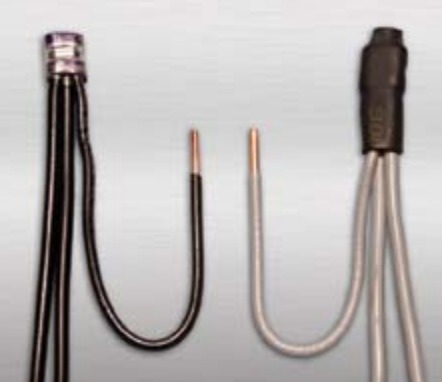
An insulating sleeve is placed around the crimp connector to complete the repair.
The copper wire pigtail is then connected to the switch, receptacle, or other termination device. Only electricians who are trained by the
manufacturer to use the tool properly are authorized to install COPALUM connectors. CPSC staff emphasizes that this training is necessary to ensure that the
electrician uses the careful, professional workmanship and thoroughness required to make the crimp connector repair safe and permanent.
An example of a repaired receptacle outlet is also illustrated below.
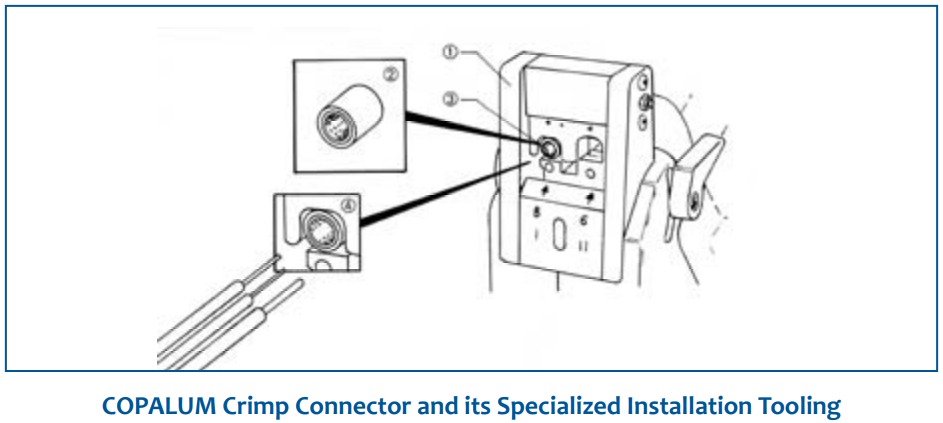
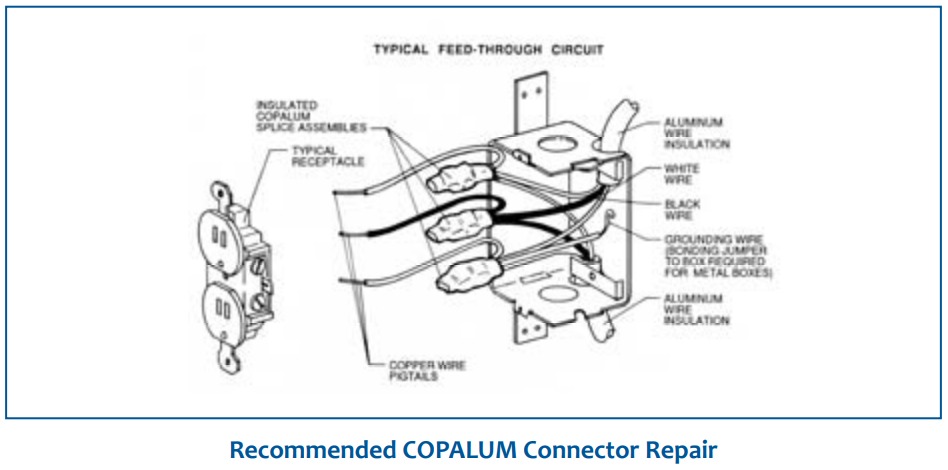
To determine if there is a COPALUM installer in your region, visit:
http://tooling. tycoelectronics.com/copalum/copalum_home.asp,
or contact the manufacturer at
(800) 722-1111 or at the following address:
TE Connectivity
Attn: COPALUM Aluminum Wire Repair
Program
P.O. Box 3608
Harrisburg, Pa. 17105
CPSC staff recognizes that copper replacement may be cost-prohibitive and that the COPALUM repair may be unavailable in a locality. Based upon an evaluation that was, in part, CPSC-supported,5
consumers are advised that, if the COPALUM repair is not available, the AlumiConn connector may be considered the next best alternative for a permanent repair. This repair method involves pigtailing using a setscrew type connector instead of the COPALUM crimp connector in the repaired connections.
The AlumiConn connector has performed well in initial tests, but is too new to have developed a significant long-term safe performance history as the COPALUM
repair. The repair should be conducted by a qualified electrician because careful, professional workmanship and thoroughness are required to make the AlumiConn connector repair safe and permanent.
![]()
For additional information on the
AlumiConn connector, visit: http://www.kinginnovation.com/products/ alumiconn, or contact the manufacturer at
(800) 633-0232, or write to the firm at the following address:
King Innovation
42 N. Central Drive
O’Fallon, Mo. 63366
Non-COPALUM Crimp Connectors
There are many other brands and types of crimp connectors — including those intended to be installed with a pliers-type of handtool — which are readily available to
consumers at common retailers. No other crimp connectors have been evaluated for connecting copper and aluminum conductors.
CPSC staff strongly recommends against their use as a repair method.
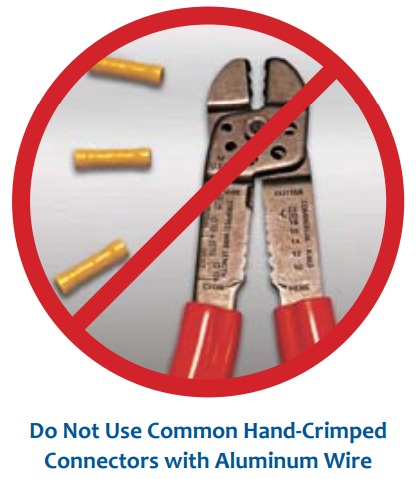
Two other repair methods described below are often recommended by some electricians because they are substantially less expensive than COPALUM crimp
connectors. CPSC staff does not consider either of these repairs an acceptable permanent repair.
The first temporary repair involves pigtailing with a twist-on connector. The effectiveness of “pigtailing” using twist-on connectors has been evaluated by CPSC
staff. In CPSC-sponsored laboratory testing and life tests, substantial numbers of these connectors overheated severely. Surveys of and statements made by electricians and electrical inspectors confirm the highly variable and often poor performance of twist-on connectors with aluminum wire.
It is possible that some pigtailing “repairs” made with twist-on connectors may be prone to even more failures than the original aluminum wire connectors. Accordingly, CPSC staff believes that this method of repair does not solve the problem of overheating present in aluminum-wired branch circuits.
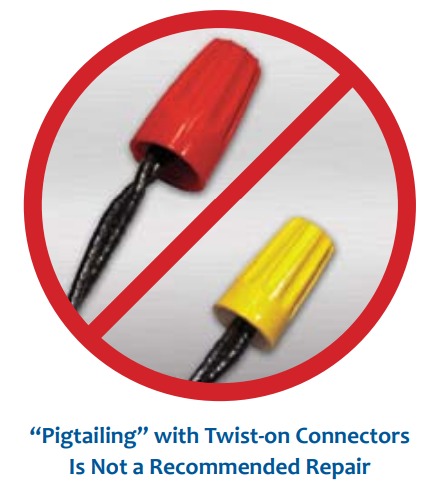
The other repair recommended by the industry is to use switches and receptacles labeled “CO/ALR.”
These devices are intended for direct connection to aluminum wire, although they can be used with copper or copper-clad wire. CO/ALR devices perform better with aluminum wire than non-CO/ALR devices when installed carefully and according to best electrical practices. However, CO/ALR wiring devices have failed in laboratory tests when connected to aluminum wire typical of that installed in existing homes. The test conditions simulated actual use conditions; no “overstress” type of testing was used.
Further, CO/ALR connectors are not available for all parts of the wiring system (e.g., for the permanently wired appliances and ceiling-mounted light fixtures).
In the opinion of CPSC staff, CO/ALR devices must be considered, at best, an incomplete repair.
AL/CU twist-on connector pigtails or CO/ALR devices may be used as an emergency, temporary repair for a failed aluminum termination.
Should such a repair be performed, CPSC staff recommends that a complete repair of the aluminum-wired system be performed using the CPSC-recommended methods as soon as possible.
All modifications and additions to the installed wiring should be performed and inspected per local regulations.